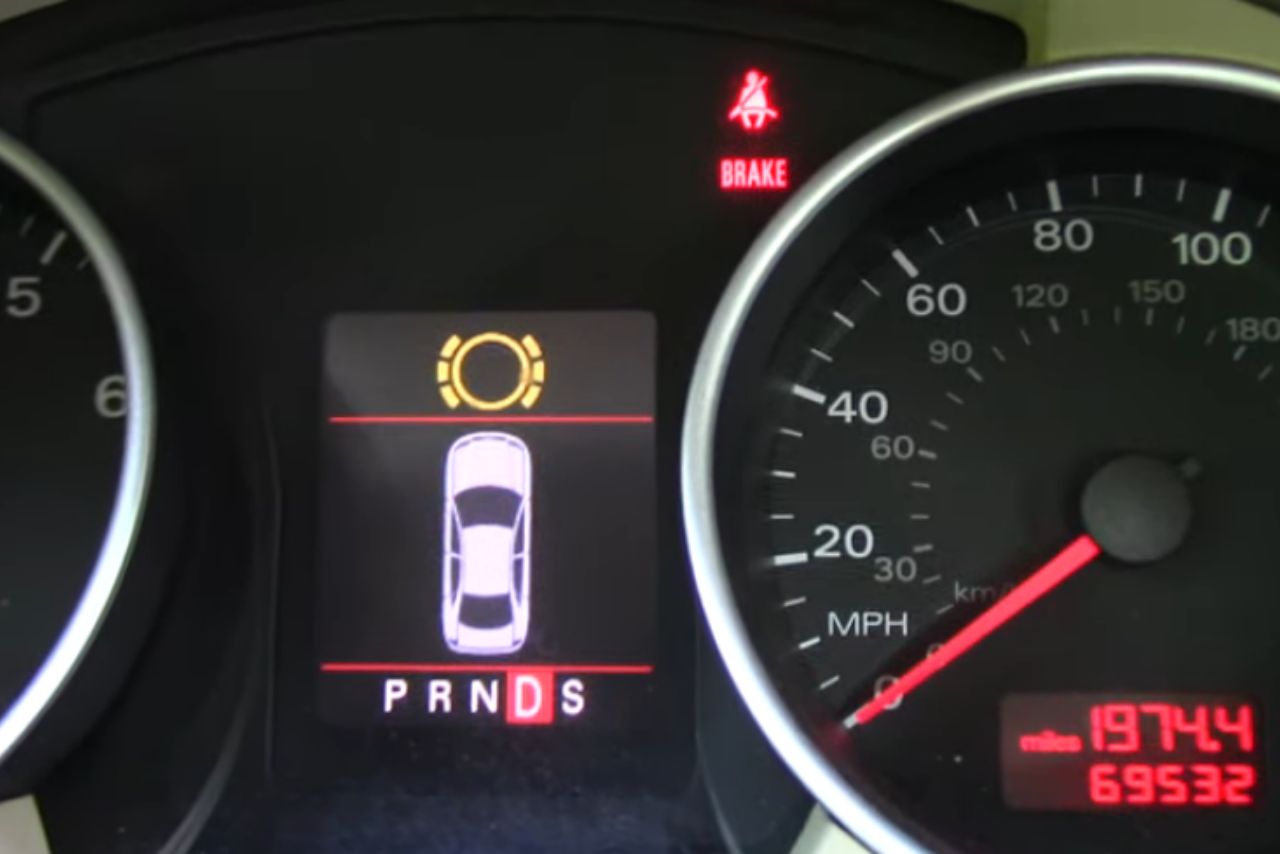When your Audi Brake Pads Warning Light Comes On, it’s a clear signal from your vehicle that it’s time for a brake pad inspection or replacement.
This common issue can be solved by replacing worn-out pads or fixing potential electrical faults in the system.
In this article, we’ll guide you through understanding why this light might come on and how to address the problem effectively.
Audi Brake Pads Warning Light Comes On? Don’t Ignore It!
SUCCESS
Your Audi’s brake pad warning light signals worn pads needing replacement. Ignoring it can damage rotors and compromise safety. Independent shops offer cost-effective and it will cost you around $360 alternatives to dealer services. Verify rotor thickness before replacement to avoid unnecessary expenses.
| Mileage | Warning Light | Service Type | Cost |
|---|---|---|---|
| 44,500 | Brake Pad | Independent Shop | $360 |
| Dealer | $1,100 |
Here In the below image You Can see the proof 

Table of Contents
Understanding the Audi Brake Pad Warning Light”
When the brake pad warning light on your Audi comes on, it can be a bit alarming. But don’t fret! The light is designed to alert you when something needs attention.
Here’s a quick breakdown of what each color means:
| Light Color | Meaning |
|---|---|
| Red | Immediate attention required. Often indicates worn out brake pads. |
| Yellow | Caution: Check as soon as possible. |
Below are steps you might want to take after seeing the light:
- Safely pull over and check if there is any visible problem with the brakes.
- If nothing seems off or if you’re unsure, head straight to an authorized repair center for professional assistance.
- Replace old/worn-out brake pads immediately (if necessary).
Remember: Safety first! Never ignore this helpful little red/yellow friend on your dashboard.
Common Reasons for the Audi Brake Pad Warning Light to Come On:

When your Audi brake pad warning light illuminates on the dashboard, it’s signaling a problem. Here are common reasons why:
Here’s a table summarizing these issues for quick reference:
| Reason | Solution |
|---|---|
| Worn Out Brake Pads | Replace with new ones |
| Faulty Sensor | Have it checked by professional |
| Low Brake Fluid Levels | Refill with appropriate fluid |
Remember to have any possible problems checked out immediately. Ignoring warnings could lead to serious consequences!
You can also watch his video for more learning:
Checking the Brake Pads for Wear and Tear:

First thing’s first, let’s understand why brake pads wear down:
Now, here are some steps to check your Audi’s brake pads for wear and tear.
| Good Condition | Bad Condition |
|---|---|
| Thick | Thin |
If less than this or uneven wear is noticeable it’s time to replace them.
- Check for Physical Damage: Besides thickness, look out for any cracks or chips on your brake pads which could indicate severe damage.
5 .Listen For Noise: A squealing sound can suggest that your brakes need checking too!
Remember – Always prioritize safety when working with vehicles!
Replacing the Worn Out Brake Pads:

When the Audi brake pad warning light comes on, it’s often a sign that your brake pads need replacement. Here’s an easy step-by-step guide to help you out.
Step 1: Gather Your Tools:
Here are some essential tools you’ll need:
Step 2: Remove the Wheel:
Step 3: Replace Brake Pads
Follow these steps:
| Steps | Instructions |
|---|---|
| Step 1 | Use car jack to lift up vehicle |
| Step 2 | Place jack stands for safety |
| Step 3 | Remove lug nuts & wheel |
| Step 4 | Locate & remove caliper assembly |
| Step 5 | Slide old brake pad out |
| Step6 Insert new pad |
Remember, always refer to your owner’s manual or consult a professional if unsure about any part of the process!
Resetting the Audi Brake Pad Warning Light:
If your Audi brake pad warning light is on, don’t panic. Here’s a quick guide to reset it:
| Step | Action |
|---|---|
| 1 | Turn off Engine |
| 2 | Locate Ignition |
| 3 | Switch to ACC Mode |
| 4 | Press Odometer Button |
| 5 | Switch Key to On Position |
| 6 | Release & Press Again |
Remember:
- If this doesn’t work at first try repeating steps.
- Don’t start car while doing process.
- Consult manual if light remains for possible errors.
Using Diagnostic Tools to Identify the Issue:
When the Audi brake pad warning light comes on, it’s time for some troubleshooting. Here are steps using diagnostic tools:
Get a Professional OBD2 Scanner:

An On-board Diagnostics II (OBD2) scanner is an essential tool that can help identify what’s causing the light to come on.
- Why use it? This device reads data from your car’s computer and indicates specific issue codes.
- Where to get one: You can find these at any auto parts store or online.
Run a Diagnostic Test:
- Plug in the OBD2 scanner into your car’s diagnostic link connector (DLC).
- Follow instructions displayed by your tool:
- Turn ignition key but don’t start engine
- Press “Read” or “Enter” button on scanner
- Note down trouble code(s)
- Follow instructions displayed by your tool:
- Interpret Codes: Each trouble code corresponds with a specific issue.
| Code | Meaning |
|---|---|
| P0500 | Vehicle Speed Sensor Malfunction |
| P0571 | Cruise Control/Brake Switch A Circuit Malfunction |
| C0036 | Left Front Wheel Speed Sensor |
You might need professional assistance if you’re unable to interpret these codes yourself.
- Address Issues Identified:
- Replace sensor based on given error, such as speed sensor or brake switch
- If no clear error, consider further inspection like checking for wear and tear of brake pads
Remember, safety first! Always consult a professional mechanic when dealing with issues related to braking systems.
Seeking Professional Help for Complex Cases:
In some cases, the Audi brake pad warning light might come on due to more complex issues that can’t be easily addressed at home. In such instances, seeking professional help becomes necessary.
Benefits of Hiring Professionals:
Here’s a simple table outlining when it’s best to seek professional help:
| Problem | DIY Fixable? | Better See a Mechanic? |
|---|---|---|
| Brake pads worn out | Yes, if experienced | Preferred |
| Warning light error | No | Yes |
| System malfunctioning | No | Yes |
Remember: It’s always safe to consult with professionals when dealing with mechanical aspects like brake systems as attempting fixes without proper knowledge may lead to further damage or compromise vehicle safety.
Preventing Future Occurrences of the Warning Light:
Keeping your Audi’s brake pad warning light at bay involves a few key practices. Stick to these recommendations and you should have fewer unexpected dashboard surprises:
For an easy reference guide, check out this basic schedule for preventive care:
| Mileage | Maintenance Tasks |
|---|---|
| Every 5k Miles | Check Brake Fluid Level |
| Every 10k Miles | Full Brake System Inspection |
| Every 20k -30k Miles | Replace Brake Pads (if required) |
Finally, always pay attention to what your car is telling you! If that warning light comes on again despite best efforts, it may signal a bigger issue needing professional attention.
Maintaining Your Audi’s Braking System Regularly:
Maintaining your Audi’s braking system is crucial. Paying attention to the brake pads warning light and performing regular checks can prevent serious problems.
Regular Inspection:
- Check your brake pads regularly, ideally every 10,000 miles.
- Inspect for wear and tear. If pad thickness is less than 3mm, it’s time for a replacement.
Brake Fluid Checks:
- Brake fluid should be replaced every two years or 20,000 miles.
- Low brake fluid levels might trigger the warning light. Keep it topped up!
Here are some maintenance steps:
- Start with Visual Inspection: Look at the brake pads through your wheel spokes.
- Check Warning Light: If lit up on dash board, immediate inspection needed.
- Listen For Noise: Any unusual squealing or grinding sound usually indicates worn out brakes.
- Feel The Pedal: A soft pedal feel when pressed could indicate a problem with the hydraulic system.
| Maintenance Steps | Frequency |
|---|---|
| Visual inspection of brake pads | Every 10000 Miles |
| Replacing Brake Fluid | Every Two Years/20000 Miles |
| Watch Out For Warning Lights And Sounds | Always |
Stick to this routine to keep your Audi’s braking system in top shape!
Conclusion and final thoughts
Audi brake pad warning light can cause an unpleasant surprise when it illuminates. Yet, armed with the right knowledge and tools, you have power to resolve this issue effectively.
Always remember that your safety on the road matters most. Thus, prompt attention to any warning lights ensures longer lifespan for your Audi and peace of mind for you.
In conclusion, taking care of your precious Audi doesn’t stop at fueling or regular washing – it extends into every little detail like addressing the brake pad warning light promptly.
Your vehicle will repay you with excellent performance and durability if treated well!
Latest Posts:
- Can WD-40 Remove Scratches on Cars? (Hint: Yes, but…)
- Can You Use a Drill to Polish Your Car? (We Tried it Out!)
- Should You Cover Car Scratches With Stickers? (REVEALED!)
- Buick Service Stabilitrak: (Causes & 100% Guaranteed Fix!)
- Common Holden Trax Problems (Causes & 100% Proven Fixes!)
- Jeep Commander Transmission Over Temp: (Guaranteed Fix!)












Leave a Reply